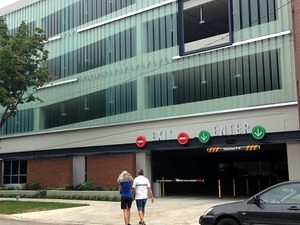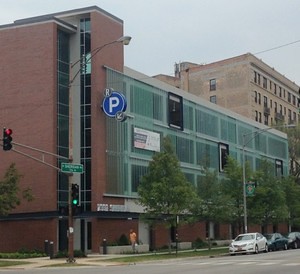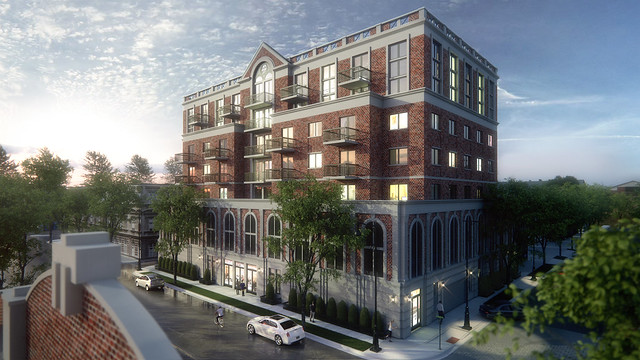
As I’ve written before, 49th Ward Alderman Joe Moore is one of the more progressive members of City Council, and he’s generally got a good record on walking, transit, and biking issues. However, Moore and billionaire real estate developer Jennifer Pritzker have become a dynamic duo when it comes to bringing auto-centric structures to Rogers Park. These buildings will only make the neighborhood more car-dependent.
Pritzker, too, deserves credit for being a historic preservationist and a bike advocate. But her development firm, Tawani Enterprises, recently completed a 250-spot parking garage a stone’s throw from the Lakefront and the Red Line’s Jarvis station. Her next project is a 45-unit rental complex with a whopping 75 car spots, virtually next door to the Morse ‘L’ stop. Moore has enabled Pritzker to move forward with both of these car-focused projects by approving the necessary zoning changes.
The alderman signed off on the garage in June of 2013. Located at the southeast corner of Sheridan Road and Sherwin Avenue, it replaced an attractive, 90-year-old home that formerly housed the Shambhala Meditation Center. The new structure will serve two nearby, Pritzker-owned buildings: Frank Lloyd Wright’s Emil Bach House, and Farcroft by the Lake, an upscale rental tower. 60 parking spaces are reserved for Farcroft residents, 84 spaces are set aside for short- and long-term paid parking for the general public, and 106 spaces will be used during Bach House events, and will be available to the public at other times.
Many local residents bitterly opposed the garage for several reasons. They argued that the monolithic structure would be out of place besides historic buildings on Sheridan and, with zero retail and a blank façade, it would make the business strip less lively. Worse, drivers entering and exiting the garage would endanger people walking on Sherwin.
Meanwhile, the hundreds of new parking spots would serve as a massive traffic generator. More cars in the neighborhood would make it harder for pedestrians to cross the street, and create traffic congestion for bus riders and more hazardous conditions for bicyclists.
In a message to constituents this morning, Moore heralded the recent opening of the parking structure. “This is not your run of the mill parking garage,” he wrote, touting its high-quality materials, roughly 5,000 square feet of ground-level green space and 800 square feet of greenery on the roof. While I don’t agree that the structure is “a stunning addition to Sheridan,” I'll concede that it’s about as attractive as any building can be whose sole purpose is to warehouse autos.
But the way Moore characterizes the garage as an asset to the local transportation scene is a bit galling. He says the structure "offers relief for parking-starved Rogers Park residents" while failing to mention that neighborhood is rich in alternatives to driving, such as excellent transit access.
He argues that 250 new parking spaces will take up to 250 cars off the street, creating less competition for curbside spaces. However, all these new parking spots will encourage residents of the Faircroft and visitors to the Bach house and other businesses to bring more automobiles into the neighborhood. Then he asks us to have compassion for the parking-starved motorist:
Unless they have the luxury of an off-street parking location to store their car, they often find themselves endlessly circling the neighborhood looking for a parking space. Or they remain stuck in their home at night, reluctant to give up their on-street parking space.
Oh, the humanity! Instead, these unfortunate souls can now pay $125 a month for an off-street parking spot in the new garage.
“This new parking structure promises to make life a little bit easier for many Rogers Park residents,” Moore concludes, and that is true. However, it will also make life a little bit harder for the many Rogers Parkers who rely on walking, transit, and biking to get around. In most Census tracts in the neighborhood, over 40 percent of households don’t own cars.
In early July, I discussed the issues with the other car-centric Pritzker project, located at the southeast corner of Morse and Wayne avenues. Moore approved it at the end of the month. On the plus side, the development will replace a suburban-style strip mall with the 45 new rental units, whose tenants will have easy access to the ‘L’ stop and pedestrian-oriented retail and entertainment.
In a long post on his website explaining why he approved the project, Moore correctly noted that, while some neighbors have argued the development is too dense for the neighborhood, the new households will be a shot in the arm for the local economy:
Some oppose the development because it will increase the population density of the neighborhood. Over-population is the least of our concerns. In fact, the number of residents in Rogers Park has decreased by over 13 percent, or nearly 8,500 people, since 2000. We need more people in Rogers Park, not less, to support the neighborhood's retail and commercial businesses.
The real problem with the development is that Tawani is ignoring the fact that this is prime real estate near a train station. They're building 50 parking spots for the Pritzker-owned Mayne Stage music theater and pub across the street, plus 25 spaces for residents. Under the city’s current transit-oriented development ordinance, only 23 total spaces are required for a 45-unit building at this location. Mayor Rahm Emanuel recently proposed a new TOD reform ordinance – if this passes, zero car spots would be required in a building like this.
Like the garage on Sheridan, the new Morse structure will encourage more people to bring automobiles into the community. If Pritzker and Moore keep promoting this kind of development, it might make sense to start calling the neighborhood "Rogers Parking Lot."







